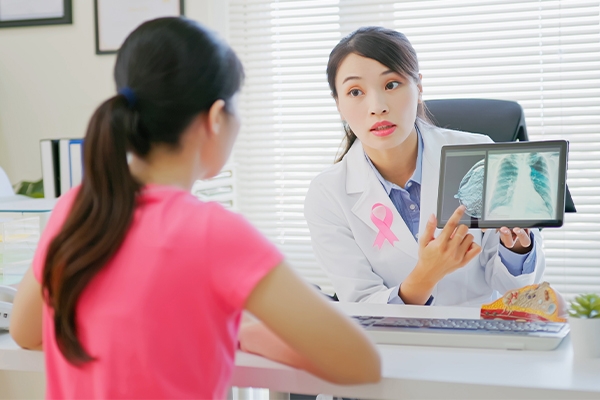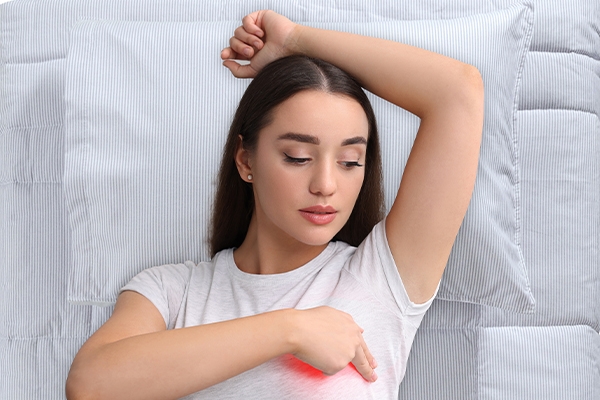Why Is There a Lump in My Breast?

A lump in the breast is concerning. However, not every lump is indicative of breast cancer. Learn about the most common causes of breast lumps and the precautions you can take to stay healthy.
First and foremost, do not be frightened if you discover a lump in your breast. Breast lumps can affect both men and women, and some of these lumps are benign.
A lump in the breast is caused by swelling, growth, or a mass. It is mainly caused by hormonal changes in the breast tissue. Therefore, don't be surprised if a lump appears or disappears unexpectedly.
Breast lumps can arise at any age, including infants, teenagers, and adults. At birth, both boys and girls might have breast lumps caused by the mother's estrogen. Breast lumps arise in girls as young as 6 or as young as 9 years old.
Meanwhile, teenage boys may experience breast growth and lumps owing to hormonal changes throughout puberty, which may resolve on their own after a few months.
Recognizing various types of breast lumps

1. Fibroadenoma
Lumps in women are most commonly fibroadenomas, which are benign or noncancerous tumors that occur in the breast. These lumps move readily in the breast tissue and are typically firm, smooth, or rubbery. They do not get bigger with time. These lumps are typically less than an inch in size, with the largest being roughly 2 inches.
In some circumstances, such as when a lump grows in size, the doctor may advise removing it.
2. Fibrocystic
Is a condition in which the tissue feels bouncy or like a bunch of ropes. It typically has no symptoms. Women aged 20 to 45 are at risk of developing fibrocystic breasts.
It usually emerges a few weeks before menstruation due to hormonal changes. Symptoms improve as menstruation begins. In fibrocystic patients, the size of the lump changes and can be shifted. There may also be soreness under the arm.
3. Cyst
It is a fluid-filled sac that, like a water balloon, feels soft when touched. Depending on the size, it can be painful. The nipples also leak a clear, yellow, or brownish liquid as a result of these cysts.
Cysts occur just prior to menstruation. Because of high quantities of the hormone estrogen, which affects changes in breast tissues and glands.
Breast cysts arise in women between the ages of 35 and 50 approaching menopause, particularly those who utilize hormone replacement therapy.
A breast lump is not the only indicator of breast cancer. Other signs of breast cancer include those listed below.
- Lumps around the armpits.
- Swelling, redness, or discoloration of the breast skin.
- Dimpling (a type of dimple) on the breast skin due to clogged lymph veins.
- The breast is either flat or indented.
- Breast size or shape change.
- Blood vessels protrude from the breast's surface.
- Acute nipple discharge.
- Nipples that itch, a rash, or soreness.
- Nipple inversion.
- Pain in a specific area of the breast.
Consult a doctor right away if you have any of the following symptoms.
Inspection
When you report a lump in your breast, your doctor may ask when you discovered it and if you have any other symptoms. The doctor will undertake a physical examination first, but if anything unusual is discovered, the following tests will be performed:
- Mammogram. An X-ray of the breast to detect breast abnormalities.
- Ultrasound. A test that creates images of your breasts.
- MRI (magnetic resonance imaging). A test that takes precise images of the breast.
- Fine needle aspiration. A needle used to remove fluid from a breast mass. Ultrasound may be utilized to guide the needle in some circumstances. Noncancerous cysts shrink when the fluid is removed. If the discharge is bloody or opaque, the anatomical pathology laboratory will examine it for cancer cells.
- Breast biopsy. Done after the above tests.
Breast Self-Examination (BSE)
Indonesia has the highest number of breast cancer patients compared to other cancer types. Breast cancer is also one of the leading causes of cancer fatalities.
According to Global Cancer Statistics (Globocan) figures for 2020, the number of new cases of breast cancer in Indonesia was 68,858 (16.6%) of a total of 396,914 new cases of cancer. More than 22,000 people died from breast cancer (kemkes.go.id, 2022).
70% of breast cancer patients are found to be in an advanced stage. Meanwhile, cancer death can be avoided via early identification. Begin with a monthly breast self-examination 3-5 days after menstruation finishes. At this point, the breasts are not too supple to make an incorrect assumption about the presence of a bump.
If you have reached menopause or your menstruation has ended, simply do it on the same date every month.
1. Lay on your back
This position allows you to detect any lumps or changes more easily. Place your right hand behind your head. Press lightly yet firmly across your breast with your three fingers on your left hand.

Squeeze the nipples lightly. See if any liquid comes out. Now, sit down and feel around your armpits. When you've finished with the right breast, go back and do it on the left.
2. Face the mirror
Examine both breasts while your hands are at your sides. Examine each breast for form. Keep an eye out for any changes in the skin, such as dimpling or wrinkles.

Also, check to see whether the nipple moves inward. Repeat the test with your hands above your head.
3. Self-examination regularly
After a few breast self-exams, you should be familiar with how your breasts look and feel. Each exam may reveal something new, such as a new lump, a change in skin texture, or nipple discharge.

Don't freak out if you detect a change. Call your doctor right away to determine the reason of these changes and, if necessary, treat them.
Before treating breast lumps, doctors must first discover the etiology. Not all breast lumps require therapy.



